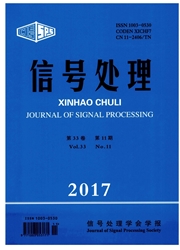

 中文摘要:
中文摘要:
常规机载雷达信号处理流程通常把脉压(PC)处理放在空时自适应处理(STAP)之前,系统要对每个空域通道的每个脉冲进行脉压,运算量很大。本文针对将PC置于STAP之后的处理结构,对其可行性进行了理论证明。该处理结构具有三个优点:一是大大降低脉压运算量(若按Ⅳ个空域通道计算,最大可降低N倍),二是提供了对脉压多普勒频移补偿的可能,三是更利于STAP中自适应权的形成。结合新处理结构的第二个优点,本文给出一种适于提高距离分辨力的脉压补偿方法。最后通过实测数据实验验证了新处理结构的可行性及脉压补偿方法的正确性。
 英文摘要:
英文摘要:
For a routine airborne radar signal processing architecture, the pulse compression (PC) is placed before the space-time adaptive processing (STAP) ,which leads to much computation for PC in each space-channel for each pulse. In this paper the PC is placed after the STAP in the signal processing architecture and the feasibility is proved. In the new signal processing architecture three merits are obtained. The first is the less computation of PC ( the least comes to N times less than that of the routine architecture for N space-channels). The second is that the possibility to compensate the Doppler shift in PC is attained. And the third is that the STAP weights are more suitable to be formed. Based on the second merit a Doppler shift compensation method suitable to improve the range resolution in PC is proposed. Finally experiments using real data are done, and the results validate the feasibility of the new architecture and the availability of the compensation method.
 同期刊论文项目
同期刊论文项目
 同项目期刊论文
同项目期刊论文
 Performance improvement for monostatic clutter mitigation using space-time-range three dimensional a
Performance improvement for monostatic clutter mitigation using space-time-range three dimensional a Unambiguous Doppler centroid estimation approach for SAR data based upon compressed signal magnitude
Unambiguous Doppler centroid estimation approach for SAR data based upon compressed signal magnitude 期刊信息
期刊信息
